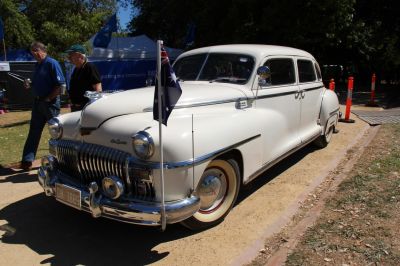 1952 DeSoto Firedome I Eight-Passenger Dimensions, Size & Specs
1952 DeSoto Firedome I Eight-Passenger Dimensions, Size & Specs
Measurements of the 1952 DeSoto Firedome I Eight-Passenger, engineered for optimal performance and comfort
| Dimensions | |
|---|---|
| Length: | 5699 mm224.4 in18.7 ft |
| Width: | 1934 mm76.1 in6.3 ft |
| Height: | 1700 mm66.9 in5.6 ft |
The 1952 DeSoto Firedome I Eight-Passenger represents a classic full-size sedan from the early 1950s, produced between 1951 and 1952. This model was designed to accommodate spacious seating with its eight-passenger capacity, reflecting the era's emphasis on family comfort and roomy interiors. Measuring a substantial 5699 mm (224.3 inches) in length, the Firedome I stands out as a large vehicle, offering generous interior volume and a commanding road presence. Its width of 1934 mm (76.1 inches) provides a stable and wide stance for comfortable passenger space and road handling, while the height of 1700 mm (66.9 inches) maintains a balanced profile typical of sedans of that time. As a key player in DeSoto’s lineup, the Firedome I Eight-Passenger combined traditional American automotive styling with an emphasis on passenger accommodation, making it ideal for larger families or those seeking a spacious ride. This model's exterior dimensions reflect the robust design language characteristic of early 1950s sedans, combining elegance with practicality. Its significant size compared to contemporary vehicles highlights the driving comfort and interior roominess prioritized during this generation's production years.
Discover the standout features that make the 1952 DeSoto Firedome I Eight-Passenger a leader in its class
Have a question? Please check our knowledgebase first.
The 1952 DeSoto Firedome I Eight-Passenger sedan measures 5699 mm (224.4 inches) in length, making it a notably long vehicle for its era. Its width is 1934 mm (76.1 inches), providing a spacious cabin footprint, and it stands 1700 mm (66.9 inches) tall, giving it a substantial road presence. These dimensions highlight its design focus on comfortable passenger space and commanding stature typical to early 1950s American full-size sedans.
The 1952 DeSoto Firedome I Eight-Passenger has a width of 1934 mm (76.1 inches), which exceeds the width of many modern sedans that typically range from about 1800 mm to 1850 mm (70.9 to 72.8 inches). This greater width provides more shoulder room for passengers, contributing to its designation as an eight-passenger vehicle. The spacious cabin allows for comfortable seating arrangements that are rare in today's midsize cars, reinforcing its full-size sedan classification.
With a height of 1700 mm (66.9 inches), the 1952 DeSoto Firedome I Eight-Passenger stands taller than many contemporary sedans, which often have heights closer to 1440 mm to 1500 mm (56.7 to 59 inches). This taller profile makes entry and exit relatively easy, as passengers do not have to crouch as much compared to lower cars. The higher seating position also enhances visibility for both drivers and passengers, contributing to a more comfortable ride experience common in classic American cars of that era.
While exact curb weight figures for the 1952 Firedome I Eight-Passenger can vary, vehicles of similar size and construction from the early 1950s generally weigh between 1800 kg to 2100 kg (approximately 3968 lbs to 4629 lbs). This relatively heavy weight results from the solid steel body construction and robust frame used at the time, providing durability though impacting fuel efficiency and acceleration compared to modern lighter vehicles.
Standard garage dimensions in modern homes typically range around 2440 mm (8 feet) wide by approximately 6100 mm (20 feet) deep. The 1952 DeSoto Firedome I Eight-Passenger sedan, with a length of 5699 mm (224.4 inches or about 18.7 feet) and width of 1934 mm (76.1 inches or about 6.3 feet), will fit comfortably within the depth of a standard garage and will leave some lateral space to spare. However, maneuvering might be tight in narrower garages, especially if there are side storage items, but overall it is suitable for typical residential garage accommodation.
The Firedome I was designed as an eight-passenger sedan, featuring three rows of seats to comfortably seat a large family or group. Thanks to the vehicle's generous width of 1934 mm (76.1 inches) and its long wheelbase, the cabin offers ample legroom and shoulder space. The third row is often a bench seat, accommodating additional passengers, which was a popular configuration in larger sedans of this era, offering flexibility that most modern sedans do not provide.
The 1952 Firedome I Eight-Passenger followed the early post-war DeSoto models, advancing somewhat in size, styling, and engineering. It retained the classic full-size sedan dimensions but often featured improved interior comfort and a more powerful HEMI V8 engine that enhanced performance. Compared to its predecessor, minor dimension changes might include slight lengthening or widening to enhance passenger space, with a styling evolution towards a more modern 1950s look. These incremental upgrades improved the Firedome's appeal in the competitive full-size market segment.
In the early 1950s, the DeSoto Firedome I competed with large family sedans from Cadillac, Buick, and Chrysler’s own brands. Its nearly 5.7-meter length and wide stance were comparable to contemporaries like the Chrysler Saratoga or the Buick Super. The Firedome's standout was the HEMI V8 engine providing strong power output. Compared to similar sedans, its eight-passenger seating was less common, emphasizing passenger capacity over sportiness. Overall, it held its own in space, power, and comfort in the classic American full-size sedan segment.
The 1952 Firedome I Eight-Passenger embodied the bold, streamlined design that defined early 1950s American cars. It featured sweeping fenders, chrome accents, and a wide grille, conveying a sense of power and prestige. The tall roofline and large windows complemented the vehicle's passenger capacity and visibility needs. This styling marked a transition period before the tailfin craze of the mid-50s, focusing on elegance and robust road presence rather than flashy ornamentation, reflecting American optimism and automotive progress post-WWII.
Owning a 1952 DeSoto Firedome I Eight-Passenger offers advantages such as spacious seating for up to eight passengers, vintage styling, and an iconic HEMI V8 engine delivering classic American muscle and sound. However, its large size (5.7 meters long and 1.9 meters wide) may present challenges such as parking, garage space considerations, and maneuverability in modern urban environments. Additionally, maintenance costs may be higher due to vintage parts and the car's weight affecting fuel efficiency. It is ideal for collectors or enthusiasts valuing historical significance and style over modern conveniences.
Discover similar sized cars.

| Production: | 1946-1949 |
|---|---|
| Model Year: | 1946 |
| Length: | 5723 mm225.3 in |
| Width: | 1956 mm77.0 in |
| Height: | 1700 mm66.9 in |

| Production: | 1946-1949 |
|---|---|
| Model Year: | 1946 |
| Length: | 5723 mm225.3 in |
| Width: | 1956 mm77.0 in |
| Height: | 1700 mm66.9 in |

| Production: | 1951-1952 |
|---|---|
| Model Year: | 1951 |
| Length: | 5699 mm224.4 in |
| Width: | 1934 mm76.1 in |
| Height: | 1680 mm66.1 in |

| Production: | 1951-1952 |
|---|---|
| Model Year: | 1951 |
| Length: | 5699 mm224.4 in |
| Width: | 1934 mm76.1 in |
| Height: | 1680 mm66.1 in |

| Production: | 1951-1952 |
|---|---|
| Model Year: | 1951 |
| Length: | 5699 mm224.4 in |
| Width: | 1934 mm76.1 in |
| Height: | 1680 mm66.1 in |
